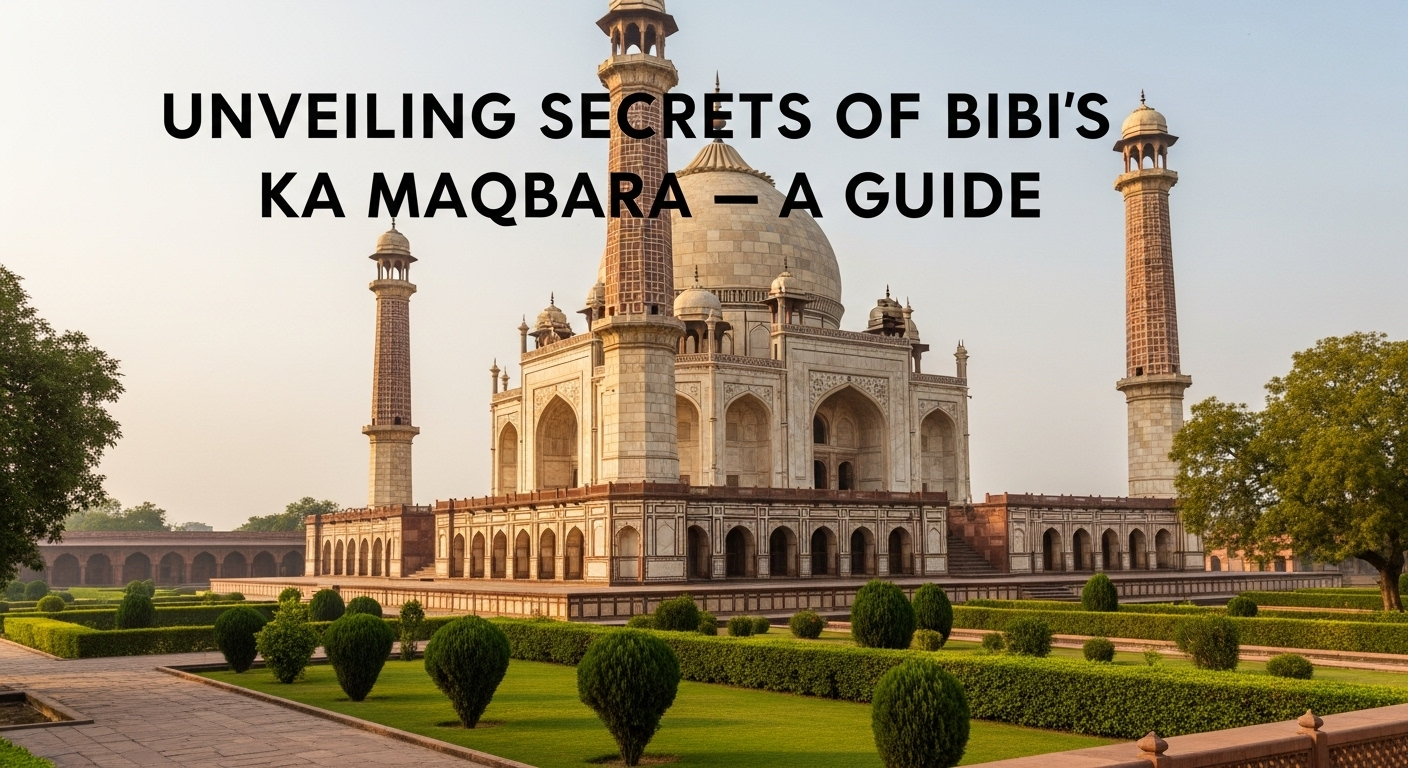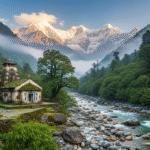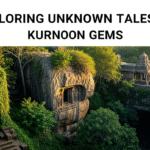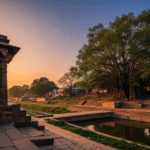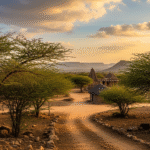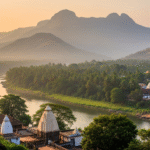Many know the Taj Mahal’s beauty, but there’s another marvel in Aurangabad. Bibi Ka Maqbara was made by Azam Shah for his mother, Empress Dilras Banu Begum. It’s known as the “Taj of the Deccan”. This place shows India’s rich Mughal history. It’s near famous UNESCO World Heritage Sites. So, Aurangabad is a must-visit for history lovers. You can start your adventure by planning a visit to Aurangabad.
The Bibi Ka Maqbara has a beauty often missed next to the Taj Mahal. It shows great dedication and amazing architecture. It takes us back in time. Getting ready to explore? Let this guide show you the stories and beauty of this place.
Key Takeaways
- A deeper insight into the secrets of Bibi Ka Maqbara, unlocking the doors to its lesser-known history and architectural mastery.
- Practical information to make your visit to Aurangabad a seamlessly enriching cultural and historical experience.
- Recognizing Aurangabad as a treasure trove of historical wonders beyond Bibi Ka Maqbara, including its marketplaces and local cuisine.
- Emphasizing the importance of hidden gems of India, underscoring the country’s extensive yet underappreciated heritage sites.
- Advice on documenting your journey, ensuring you capture the ethereal beauty of this architectural wonder while respecting its cultural gravitas.
The Enigmatic History of Bibi Ka Maqbara
The Bibi Ka Maqbara is known as the “Taj of the Deccan.” It is a beautiful example of architecture from the Mughal era. It also shows a son’s love for his mother. Located in Aurangabad, Maharashtra, this tomb is a touching part of India’s history. It shares the emotional and architectural heritage of the Mughal Empire.
Diving into Its Historical Significance
The Bibi Ka Maqbara’s history is tied with the culture of 17th-century India. Azam Shah built it in 1678 for his mother, Dilras Banu Begum, known as Rabia-ul-Daurani. Its design shows the Mughal era’s style. It uses techniques and decorations loved for centuries.
Exploring the Mausoleum’s Inspiration: Comparison with the Taj Mahal
The Bibi Ka Maqbara is often compared to the Taj Mahal. Yet, it has its own special charm and story. Seen as a tribute to the Taj Mahal, it aimed to mirror that beauty. It has similar marble and detailed carvings.
It may not be as grand as the Taj Mahal. Still, its value as a piece of Mughal architecture is clear. It shares a physical and spiritual resemblance with the Taj Mahal. This shows in its domed design and minarets. These features remind us that great beauty was a way to show love and remember.
Architectural Marvels of Bibi Ka Maqbara
The Bibi Ka Maqbara is known as the “Taj of the Deccan.” It’s a beautiful example of Mughal architecture. It combines styles from Persian, Turkish, and Indian designs. Built in 1678 in Aurangabad, Maharashtra, it was made by Azam Shah for his mother, Dilras Banu Begum. This building looks a lot like the famous Taj Mahal.
https://www.youtube.com/watch?v=5i-90tHZfQA
The details of this mausoleum show off Mughal design skills. It has a big dome with four smaller ones around it. This design makes a stunning outline against the sky. The marble work and inlay techniques show the talent of the artisans.
Decoding the Indo-Islamic Construction Techniques
The Bibi Ka Maqbara uses Indo-Islamic construction methods. It combines red sandstone with marble for a striking look. These materials were chosen for their strength and ability to handle the weather. They help keep the building standing and looking great over the years.
Understanding the Layout and Design Elements
At the Bibi Ka Maqbara, everything is symmetrical. This symmetry starts with the central dome and goes down to the gardens and gateways. It makes the place look balanced and beautiful from every view. The design focuses on the cenotaph in the middle. This area uses a lot of marble, a key feature of Mughal buildings.
Every part of the Bibi Ka Maqbara’s compound adds to its beauty. The charbagh layout includes gardens, water channels, and fountains. These were very advanced for their time. They make the area around this historic monument calm and beautiful.
The Gardens of Bibi Ka Maqbara: A Blend of Nature and Design
The Bibi Ka Maqbara gardens show the beauty of Mughal gardens. They follow the Charbagh layout, showing paradise like in Islamic architecture. These gardens are more than pretty flowers. They match the importance and seriousness of the mausoleum.
The gardens are split into four parts by paths and waterways. This design blends art and meaning. It combines human work and nature’s beauty. This creates a peaceful place. It makes the area feel calm.
Landscaping of Bibi Ka Maqbara uses the land’s natural tilt. It features terraces, water channels and paths. These lead visitors on a beautiful journey. Water features like fountains and pools make the site look better. They also cool the area, showing Mughal cleverness.
| Feature | Description | Symbolic Meaning |
|---|---|---|
| Quadrants | Four divided sections of the garden | Represents the four rivers of paradise |
| Water Channels | Network of flowing water throughout the garden | Symbolizes life and purity |
| Fountains | Strategically placed within the garden | Enhances aesthetic and auditory senses |
| Pathways | Guided walks through the garden | Represents the journey of life |
Nature and design come together in these gardens. They create a spiritual place for thinking and peace. This makes the Bibi Ka Maqbara gardens special. They match the site’s grand look perfectly.
Visitor Information: Planning Your Trip to Bibi Ka Maqbara
For those intrigued by the architectural grandeur and historical significance of Bibi Ka Maqbara, planning a visit requires a blend of practical travel advice and insights into the mausoleum’s accessibility. The monument, a testament to the region’s cultural heritage, offers a wonderful experience if approached with well-informed preparation.
Best Time to Visit and Cultural Norms
The best time to visit Bibi Ka Maqbara is from October to February. During these months, Aurangabad has cooler, pleasant weather. This lets tourists explore the site comfortably. They can see the design details without the extreme heat of late spring and summer.
When visiting, it’s important to respect local customs. Dress modestly and act politely at the mausoleum. This shows respect for the culture and norms of the region.
Facilities and Accessibility for Tourists
Mausoleum accessibility is very important. It makes sure all visitors can enjoy Bibi Ka Maqbara. The site has ramps and smooth pathways. This makes visiting Bibi Ka Maqbara easy for everyone.
There are extra services to improve the visit. For example, guided tours explain the history and architecture of the mausoleum. These tours offer a deep dive into its past.

In conclusion, a trip to Bibi Ka Maqbara is very rewarding. It doesn’t matter if you love history, architecture, or culture. With the right planning, your visit will be memorable. Follow these travel tips for Aurangabad to enjoy this important monument fully.
| Facility Type | Availability |
|---|---|
| Guided Tours | Available daily |
| Accessibility Ramps | Available at all entrances |
| Visitor Center | Equipped with restrooms and a gift shop |
| Parking Area | Spacious and close to the main entrance |
Secrets of Bibi Ka Maqbara
Bibi Ka Maqbara shines with beauty and mystery. It holds secrets that spark the curiosity of those who visit. The hidden chambers of Bibi Ka Maqbara and its lesser-known facts make the monument even more intriguing. Such details promise stories filled with mystery and the whispers of ancient secrets.
Unlocking the Mysteries of Hidden Chambers
Hidden chambers inside Bibi Ka Maqbara stir curiosity and research. They turn the site from just a grave into a treasure of history. These areas, closed to visitors, might hold clues to the monument’s mysterious history. This includes royal secrets to hidden treasures. Researchers are eager to discover all there is, hoping to fully understand the site’s story.
The Story Behind the Lesser-Known Inhabitants
The story of Bibi Ka Maqbara goes beyond its construction. It includes the people who lived and worked there. Their lives are overshadowed by the site’s beauty. Yet, their stories of struggle and success add a deep human touch to the place. They show the real contrast between history and the fleeting nature of human life.
The beauty of Bibi Ka Maqbara is more than what we see. It’s also in the secrets the corridors might hide. Visitors often leave filled with wonder. They think about the stories the hidden chambers could tell. With ongoing research, Bibi Ka Maqbara stands as more than a symbol of love. It’s a place full of secrets waiting to be told.
Restoration and Conservation Efforts: Safeguarding Heritage
The conservation of Bibi Ka Maqbara is very important. It’s historical and cultural value in Maharashtra is huge. This big effort tackles many restoration challenges. These include damage from the weather and the aging of materials. Various government bodies and NGOs help out. They start projects to strengthen the structure and keep its beauty.
Challenges in Preserving the Mausoleum
Preserving Bibi Ka Maqbara has its own set of problems. These include the marble and stone getting worse. This is because of Maharashtra’s changing weather. Urban growth and lots of tourists also bring threats. These problems challenge the upkeep of the mausoleum and its surroundings. Conservation relies on sustainable practices. These take care of several issues while honoring the monument’s history.
Roles of Government and NGOs in Preservation
The government and NGOs are key in preserving Bibi Ka Maqbara’s heritage. They work together on restoration projects. These projects fix old masonry and try to stop more damage. Their joint efforts make sure conservation follows international standards. They also consider Maharashtra’s unique heritage needs.
| Material | Usage | Importance |
|---|---|---|
| Basalt | Widely used in fortifications and temple construction | Noted for its durability and natural strength |
| Granite | Common in colonial buildings and grand colonnades | Appreciated for its longevity and aesthetic appeal |
| Laterite | Favored in coastal Maharashtra for local structures | Chosen for ease of carving and availability |
In conclusion, the hard work in conserving Bibi Ka Maqbara is very important. The challenges are big, but there is strong commitment. Many groups make sure this beautiful place continues to amaze everyone.
The Myths and Legends Surrounding Bibi Ka Maqbara
Bibi Ka Maqbara is a breathtaking site, often called the Taj Mahal’s lesser-known sibling. It’s wrapped in the mystery of Bibi Ka Maqbara myths, legends, and oral histories. These stories tell of love, betrayal, and hidden treasures, adding to its mystique.
A well-known legend speaks of a cursed treasure hidden inside the mausoleum. It was hidden by a Moghul prince to support his fight against his brother. Over time, this story has become a key part of Aurangabad’s charm.
Oral histories say the mausoleum was built as a symbol of a son’s love for his mother. It is similar to the story of the Taj Mahal. However, some say Bibi Ka Maqbara has secret rooms and spirits. People hear whispers there at twilight.
There are tales of a rivalry with the Taj Mahal too. The stories suggest Bibi Ka Maqbara’s flaws were deliberately made. This was to honor the Taj Mahal’s beauty. These tales, though not based on fact, make the site more fascinating.
These legends have been shared for generations, making them a big part of the local culture. They draw in scholars and tourists. Every story, shared by guides or the wind, invites visitors to discover the site and its mysteries.
Photographing Bibi Ka Maqbara: Tips for Capturing Its Beauty
Visiting Bibi Ka Maqbara is great for both new and skilled photographers. It sits in historical Aurangabad, rich with culture. This brief guide will help you take amazing photos while respecting the site.
Best Spots for Photography Within the Complex
The Bibi Ka Maqbara is famous for its photogenic spots. Start at the main gateway for a great first picture. The gardens provide beautiful views, especially with the sun rising or setting. Near the water channels, you can get perfect reflections of the monument.
Respecting Cultural Sensitivities While Snapping Pictures
When taking photos at Bibi Ka Maqbara, be discreet and respectful. Follow signs and avoid off-limit areas, especially near sacred spots. Be mindful about using flash and big cameras to not bother others.

Learn about local customs to honor the cultural heritage. Exploring other sites in Maharashtra is also rewarding. Check out the best places to visit here. From Mumbai’s vibes to Matheran’s serenity, there’s a lot for photographers.
| Location | Recommended Photo Spots | Cultural Tips |
|---|---|---|
| Main Gateway | Frontal shots capturing the full arch | Be wary of entry timings and large crowds |
| Gardens | Pathways, floral frames around the mausoleum | Respect plant life, stick to pathways |
| Water Channels | Symmetrical reflections of the mausoleum | Avoid touching or contaminating the water |
Preparing to visit Bibi Ka Maqbara means more than taking pictures. It’s about valuing its spirit and culture. With these tips, you can make beautiful and respectful pictures of this beloved place.
Conclusion
As we finish our tour of Bibi Ka Maqbara, we think about its beauty and historical role. This beautiful place in Aurangabad reminds us of India’s rich history. It tells ongoing stories of times past.
Visiting here makes any trip to Aurangabad special. It draws people from everywhere to learn about history.
Walking through this landmark teaches us about Indo-Islamic architecture. It also shows off the beauty around the structure. This place may not be as famous as the Taj Mahal. Yet, it gives a unique look at history.
It’s perfect for those who love history or want peace. Visitors get to see into the past. This adds to our understanding of India’s history.
Every trip here helps us value India’s architecture more. When people leave, they remember this place’s cultural importance. It connects them to Aurangabad’s history forever.
This place is more than a monument; it’s a light of India’s past. It’s important for everyone, from photographers to curious visitors. Bibi Ka Maqbara is a key part of India’s history.
FAQ
What are the secrets of Bibi Ka Maqbara?
Bibi Ka Maqbara has hidden rooms and paths. These secrets remind us of its mysterious history. Less is known about them, but explorers are trying to learn more.
Why is Bibi Ka Maqbara considered a hidden gem of India?
It’s seen as a hidden treasure because it’s not as famous as the Taj Mahal. But it’s just as grand and special. It’s a peaceful and beautiful place that shows off old Mughal building styles.
What is the historical significance of Bibi Ka Maqbara?
It marks the Mughal era’s building designs and links to the Taj Mahal. Built for Emperor Aurangzeb’s wife, it showcases the era’s beauty and skill.
How does Bibi Ka Maqbara’s architecture compare to the Taj Mahal’s?
It was made to look like the Taj Mahal, with a similar shape and dome. It’s smaller and simpler but still shows the influence of Mughal designs. It honors a son’s love for his mother.
What architectural details are unique to Bibi Ka Maqbara?
Its special parts include Mughal-style gardens and Persian marble and stone designs. These features make it stand out among Mughal monuments.
What is the landscaping style of the gardens surrounding Bibi Ka Maqbara?
The gardens are done in a Charbagh style, which is a four-part garden design. It’s known for its balance and central waterways and fountains.
When is the best time to visit Bibi Ka Maqbara, and what cultural norms should visitors be aware of?
Visit from October to February for cool, nice weather. Wear simple clothes and act respectfully at this historic place.
What facilities and accessibility features can tourists expect at Bibi Ka Maqbara?
Visitors can look forward to guide services that teach about its design and history. The site is also made to be easy for everyone to get around.
Are there preservation challenges for Bibi Ka Maqbara?
Yes, it faces issues like weather damage and aging. Efforts to repair and keep it beautiful are ongoing.
How are the government and NGOs involved in the conservation of Bibi Ka Maqbara?
They work hard to fix and take care of the site. This includes fixing stones and managing the effects of cities and tourists.
What are some of the myths and legends associated with Bibi Ka Maqbara?
Stories of love, betrayal, and hidden treasures are linked to it. These stories add to its charm and are important to local culture.
Where are the best spots for photography within the Bibi Ka Maqbara complex?
Great photo spots are the main entrance, gardens, and water areas. They let you take really nice and balanced pictures of the site.
What photography advice is provided for respecting cultural heritage at Bibi Ka Maqbara?
Be careful to respect culture and follow rules when taking photos, especially in holy or off-limits areas. This helps keep a good experience for all and honors the place’s importance.
